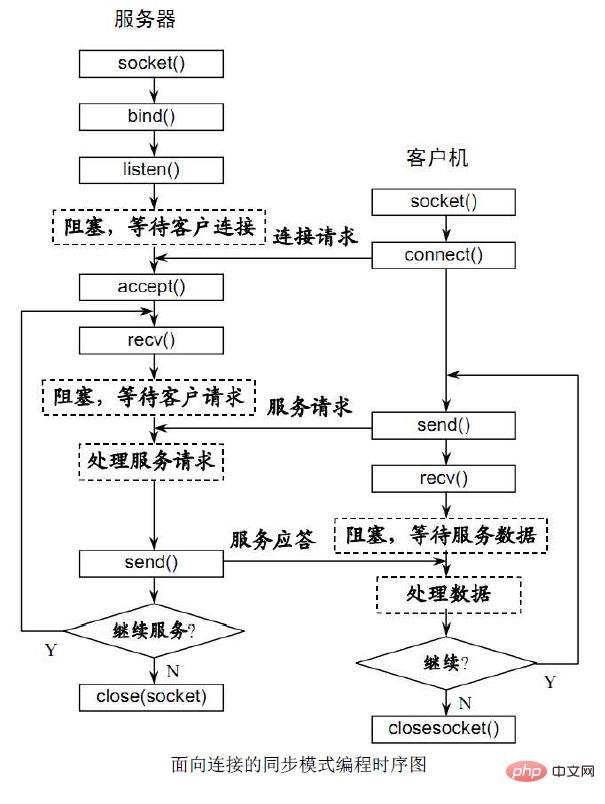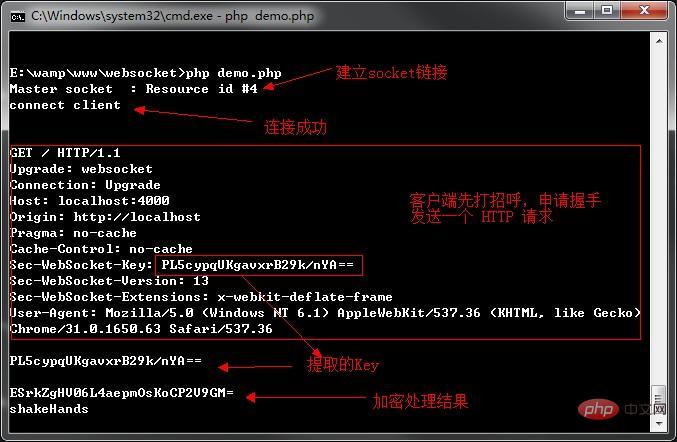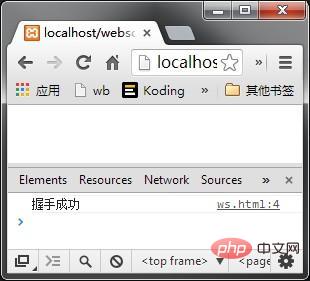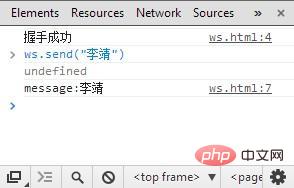

Below I drew a picture to demonstrate the handshake part when establishing a websocket connection between client and server. This part can be completed very easily in node, because the net module provided by node has already Socket sockets are encapsulated. When using them, developers only need to consider the interaction of data without having to deal with the establishment of connections. However, PHP does not. From socket connection, establishment, binding, monitoring, etc., we need to operate these ourselves, so it is necessary to talk about it again.
+--------+ 1.发送Sec-WebSocket-Key +---------+
| | --------------------------------> | |
| | 2.加密返回Sec-WebSocket-Accept | |
| client | <-------------------------------- | server |
| | 3.本地校验 | |
| | --------------------------------> | |
+--------+ +--------+Students who read the last article I wrote should have a relatively comprehensive understanding of the above picture. ① and ② are actually an HTTP request and response, but what we get during the processing is an unparsed string. For example:
GET /chat HTTP/1.1 Host: server.example.com Origin: http://example.com
The request we usually see looks like this. When this thing reaches the server, we can get this information directly through some code libraries.
WebSocket connection is initiated by the client, so everything must start from the client. The first step is to parse the Sec-WebSocket-Key string sent by the client.
GET /chat HTTP/1.1 Host: server.example.com Upgrade: websocket Connection: Upgrade Sec-WebSocket-Key: dGhlIHNhbXBsZSBub25jZQ== Origin: http://example.com Sec-WebSocket-Protocol: chat, superchat Sec-WebSocket-Version: 13
The format of the client request is also mentioned in the previous article (as above). First, php establishes a socket connection and monitors the port information.
Regarding the establishment of socket, I believe many people who have studied computer network in college know it. The following is a process of establishing a connection:

// 建立一个 socket 套接字 $master = socket_create(AF_INET, SOCK_STREAM, SOL_TCP); socket_set_option($master, SOL_SOCKET, SO_REUSEADDR, 1); socket_bind($master, $address, $port); socket_listen($master);
Compared with node, the processing of this place is really troublesome. The above lines of code do not establish a connection, but these codes are necessary to establish a socket. Something to write about. Since the processing process is slightly complicated, I wrote various processes into a class to facilitate management and calling.


//demo.php
Class WS {
var $master; // 连接 server 的 client
var $sockets = array(); // 不同状态的 socket 管理
var $handshake = false; // 判断是否握手
function __construct($address, $port){
// 建立一个 socket 套接字
$this->master = socket_create(AF_INET, SOCK_STREAM, SOL_TCP)
or die("socket_create() failed");
socket_set_option($this->master, SOL_SOCKET, SO_REUSEADDR, 1)
or die("socket_option() failed");
socket_bind($this->master, $address, $port)
or die("socket_bind() failed");
socket_listen($this->master, 2)
or die("socket_listen() failed");
$this->sockets[] = $this->master;
// debug
echo("Master socket : ".$this->master."\n");
while(true) {
//自动选择来消息的 socket 如果是握手 自动选择主机
$write = NULL;
$except = NULL;
socket_select($this->sockets, $write, $except, NULL);
foreach ($this->sockets as $socket) {
//连接主机的 client
if ($socket == $this->master){
$client = socket_accept($this->master);
if ($client < 0) {
// debug
echo "socket_accept() failed";
continue;
} else {
//connect($client);
array_push($this->sockets, $client);
echo "connect client\n";
}
} else {
$bytes = @socket_recv($socket,$buffer,2048,0);
if($bytes == 0) return;
if (!$this->handshake) {
// 如果没有握手,先握手回应
//doHandShake($socket, $buffer);
echo "shakeHands\n";
} else {
// 如果已经握手,直接接受数据,并处理
$buffer = decode($buffer);
//process($socket, $buffer);
echo "send file\n";
}
}
}
}
}
}demo.php Handshake connection test code
The above code was debugged by me, no It's a big problem. If you want to test it, you can type php /path/to/demo.php in the cmd command line; of course, the above is just a class. If you want to test it, you have to create a new instance. .
$ws = new WS('localhost', 4000);The client code can be slightly simpler:
var ws = new WebSocket("ws://localhost:4000");
ws.onopen = function(){
console.log("握手成功");
};
ws.onerror = function(){
console.log("error");
};Run the server code. When the client connects, we can see:

You can clearly see the entire communication process through the above code. The first is to establish a connection. This step in node has been encapsulated in the net and http modules, and then determines whether to shake hands. If not, shakeHands. For the handshake here, I directly echoed a word to indicate that this thing was carried out. We mentioned the handshake algorithm earlier, so I wrote it directly here.
function getKey($req) {
$key = null;
if (preg_match("/Sec-WebSocket-Key: (.*)\r\n/", $req, $match)) {
$key = $match[1];
}
return $key;
}This is relatively simple, direct regular matching, the websocket information header must contain Sec-WebSocket-Key, so we can match it quickly~
function encry($req){
$key = $this->getKey($req);
$mask = "258EAFA5-E914-47DA-95CA-C5AB0DC85B11";
return base64_encode(sha1($key . '258EAFA5-E914-47DA-95CA-C5AB0DC85B11', true));
}Encrypt the SHA-1 encrypted string with base64 again. If the encryption algorithm is wrong, the client will directly report an error when checking:

function dohandshake($socket, $req){
// 获取加密key
$acceptKey = $this->encry($req);
$upgrade = "HTTP/1.1 101 Switching Protocols\r\n" .
"Upgrade: websocket\r\n" .
"Connection: Upgrade\r\n" .
"Sec-WebSocket-Accept: " . $acceptKey . "\r\n" .
"\r\n";
// 写入socket
socket_write(socket,$upgrade.chr(0), strlen($upgrade.chr(0)));
// 标记握手已经成功,下次接受数据采用数据帧格式
$this->handshake = true;
} Ten million here It should be noted that each request and corresponding format has a blank line at the end, which is \r\n. I lost this thing when I started testing and struggled with it for a long time.

When the client successfully checks the key, the onopen function will be triggered:

// 解析数据帧
function decode($buffer) {
$len = $masks = $data = $decoded = null;
$len = ord($buffer[1]) & 127;
if ($len === 126) {
$masks = substr($buffer, 4, 4);
$data = substr($buffer, 8);
} else if ($len === 127) {
$masks = substr($buffer, 10, 4);
$data = substr($buffer, 14);
} else {
$masks = substr($buffer, 2, 4);
$data = substr($buffer, 6);
}
for ($index = 0; $index < strlen($data); $index++) {
$decoded .= $data[$index] ^ $masks[$index % 4];
}
return $decoded;
}这里涉及的编码问题在前文中已经提到过了,这里就不赘述,php 对字符处理的函数太多了,也记得不是特别清楚,这里就没有详细的介绍解码程序,直接把客户端发送的数据原样返回,可以算是一个聊天室的模式吧。
// 返回帧信息处理
function frame($s) {
$a = str_split($s, 125);
if (count($a) == 1) {
return "\x81" . chr(strlen($a[0])) . $a[0];
}
$ns = "";
foreach ($a as $o) {
$ns .= "\x81" . chr(strlen($o)) . $o;
}
return $ns;
}
// 返回数据
function send($client, $msg){
$msg = $this->frame($msg);
socket_write($client, $msg, strlen($msg));
}客户端代码:
var ws = new WebSocket("ws://localhost:4000");
ws.onopen = function(){
console.log("握手成功");
};
ws.onmessage = function(e){
console.log("message:" + e.data);
};
ws.onerror = function(){
console.log("error");
};
ws.send("李靖");在连通之后发送数据,服务器原样返回:

客户端在握手时的请求中有Sec-WebSocket-Version: 13,这样的版本标识,这个是一个升级版本,现在的浏览器都是使用的这个版本。而以前的版本在数据加密的部分更加麻烦,它会发送两个key:
GET /chat HTTP/1.1 Host: server.example.com Upgrade: websocket Connection: Upgrade Origin: http://example.com Sec-WebSocket-Protocol: chat, superchat Sec-WebSocket-Key1: xxxx Sec-WebSocket-Key2: xxxx
如果是这种版本(比较老,已经没在使用了),需要通过下面的方式获取
function encry($key1,$key2,$l8b){ //Get the numbers preg_match_all('/([\d]+)/', $key1, $key1_num); preg_match_all('/([\d]+)/', $key2, $key2_num);
$key1_num = implode($key1_num[0]);
$key2_num = implode($key2_num[0]);
//Count spaces
preg_match_all('/([ ]+)/', $key1, $key1_spc);
preg_match_all('/([ ]+)/', $key2, $key2_spc);
if($key1_spc==0|$key2_spc==0){ $this->log("Invalid key");return; }
//Some math
$key1_sec = pack("N",$key1_num / $key1_spc);
$key2_sec = pack("N",$key2_num / $key2_spc);
return md5($key1_sec.$key2_sec.$l8b,1);
}只能无限吐槽这种验证方式!相比 nodeJs 的 websocket 操作方式:
//服务器程序
var crypto = require('crypto');
var WS = '258EAFA5-E914-47DA-95CA-C5AB0DC85B11';
require('net').createServer(function(o){
var key;
o.on('data',function(e){
if(!key){
//握手
key = e.toString().match(/Sec-WebSocket-Key: (.+)/)[1];
key = crypto.createHash('sha1').update(key + WS).digest('base64');
o.write('HTTP/1.1 101 Switching Protocols\r\n');
o.write('Upgrade: websocket\r\n');
o.write('Connection: Upgrade\r\n');
o.write('Sec-WebSocket-Accept: ' + key + '\r\n');
o.write('\r\n');
}else{
console.log(e);
};
});
}).listen(8000);多么简洁,多么方便!有谁还愿意使用 php 呢。。。。
本文没有给出 decodeFrame 这样数据帧解析代码,前文中给出了数据帧的格式,解析纯属体力活。
对这部分感兴趣的同学,可以再去深究。提供了参考代码下载。
socketo.me Ratchet 为 php 封装的一个 WebSockets 库。 ]
Google 上搜索 php+websoket+class,也能找到不少相关的资料。
推荐教程:《php教程》
The above is the detailed content of PHP article details websocket. For more information, please follow other related articles on the PHP Chinese website!